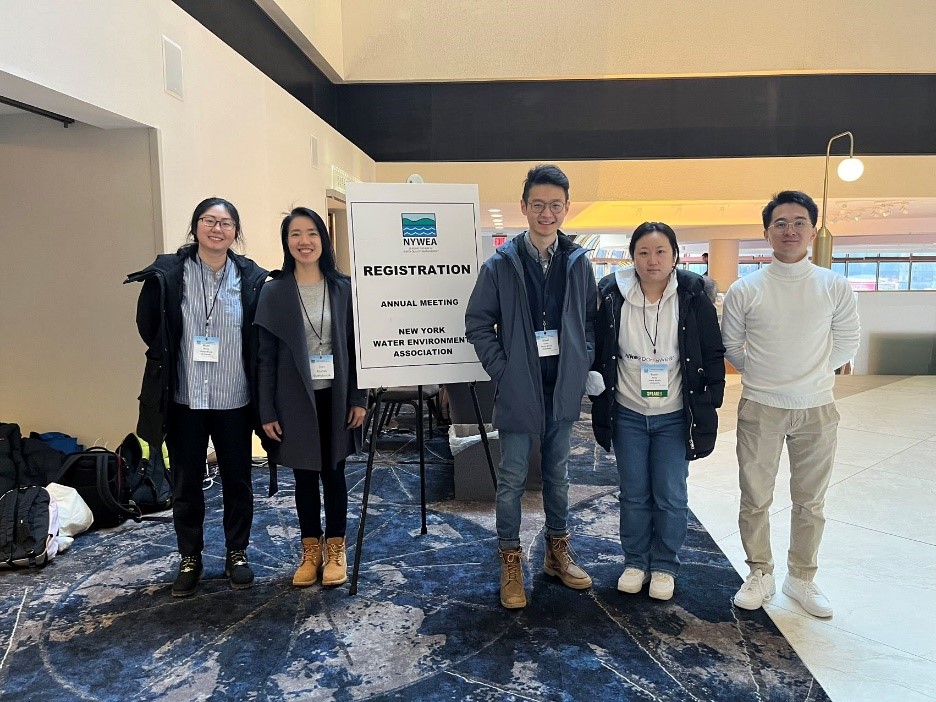Center Researchers Attend NYWEA 95th Annual Meeting
 February 8, 2023 - Center graduate students Yuyin Tang, Fanjian Zeng, Siwei Chen, and Xiumei Jian and
Postdoctoral Associate Dr. Mian Wang attended the NYWEA95th Annual Meeting to present on their research. Siwei Chen was awarded first place in the Student Paper Competition.
February 8, 2023 - Center graduate students Yuyin Tang, Fanjian Zeng, Siwei Chen, and Xiumei Jian and
Postdoctoral Associate Dr. Mian Wang attended the NYWEA95th Annual Meeting to present on their research. Siwei Chen was awarded first place in the Student Paper Competition.
- Yuyin Tang presented her 1,4-dioxane removal project as part of the Emerging Contaminants session
- Fanjian Zeng and Siwei Chen presented their work as part of the University Forum session
- Dr. Mian Wang presented the Phosphorus removal project as part of the Research & Innovation session
Yuyin Tang (presented on 2/7/2023, 11:30 am)
Evaluation of Biological Activated Filter for 1,4-Dioxane Removal from Contaminated Groundwater
Summary: The purpose of this study is to investigate the feasibility of using continuous flow bioaugmented granular activated carbon filter (BAFs) to treat 1,4-dioxane contaminated groundwater at environmental relevant concentrations (< 1mg/L). Bench-scale BAFs were set up to investigate the effectiveness of the temporary adsorption by granular activated carbon (GAC) and subsequent metabolic degradation to treat 1,4-dioxane at environmentally relevant concentrations. Current system operation result had demonstrated the continuous metabolic 1,4-dioxane biodegradation with the influent concentration as low as 100 μg/L. With the influent concentration of 100 μg/L, the system achieved ~70% removal of 1,4-dioxane.
Fanjian Zeng (presented on 2/7/2023, 3:50 pm)
Phosphorus Removal by Onsite Wastewater Treatment Systems (OWTS) - A case study in Suffolk county, NY
Summary: In this study, we reviewed the residential phosphorus (P) pollution of ground and surface waters environments in New York State. The fate and transport of P species in different environments were evaluated. Currently available and prospectively useful technologies for the removal of P from residential wastewater were identified. In the case study, we monitored the P removal performance by existing NRBs and I/A OWTS in Suffolk County, New York. The influent P varied significantly (0.6 ~ 22.1 mg/L) at all test sites. A wide range of P removal efficiency was observed in all three configurations of NRB systems (50.4% ~ 95.6%). And there was no significant seasonal change and was no significant drop of TP removal efficiency were observed.
Siwei Chen (presented on 2/7/2023, 4:10 pm)
Optimal N Removal from Onsite Wastewater Treatment Using a Novel Biofiltration System - Filter Material Optimization
Summary: Passive biofiltration system is an economically feasible technology for nitrogen removal from onsite wastewater. However, the conventional design requires a large system footprint to accommodate the limited treatment capacity and its high clogging potential also enhances the maintenance demand and cost. This presentation introduced the design of a novel continuous flow biofilter (FlexTreatTM Biofilter) with adjustable recirculation to achieve small footprint and efficient nitrogen removal. At the meantime, bench-scale column experiment was conducted to select the optimum filtration material to overcome the hydraulic challenge of FlexTreatTM Biofilter.
Dr. Mian Wang (presented on 2/8/2023. 3:30 pm)
Attenuation and Mobilization of Phosphorus in Biofilters Treating Onsite Wastewater
Summary: The goal of this study is to investigate the P attenuation and leaching process within the nitrogen removal biofilters (NRBs) when treating STE at different environmental and operational conditions. Results show that NRBs are capable of removing P, but all Total-P attenuated in the systems were completely leached out after exposure to rainwater. These results reveal risks in installing sand filtration systems for onsite wastewater treatment near water bodies due to the high potential of P leaching during rainfall. The results were important for understanding the P attenuation capacity in soil-based OWTS, and provide insight on the modular-based P removal OWTS design.
